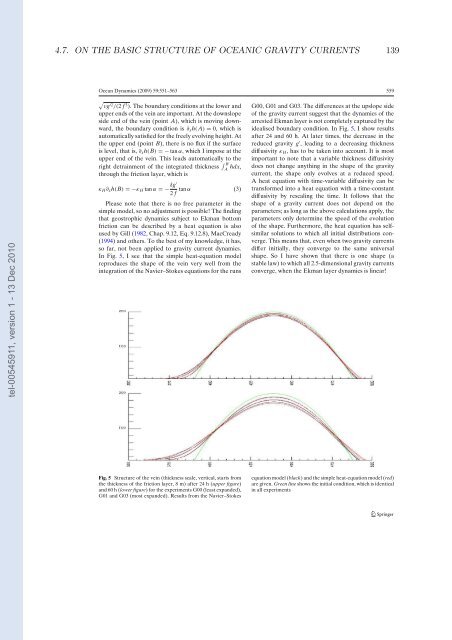Etudes et évaluation de processus océaniques par des hiérarchies ...
Etudes et évaluation de processus océaniques par des hiérarchies ...
Etudes et évaluation de processus océaniques par des hiérarchies ...
Create successful ePaper yourself
Turn your PDF publications into a flip-book with our unique Google optimized e-Paper software.
4.7. ON THE BASIC STRUCTURE OF OCEANIC GRAVITY CURRENTS 139<br />
Ocean Dynamics (2009) 59:551–563 559<br />
tel-00545911, version 1 - 13 Dec 2010<br />
√<br />
νg<br />
′2<br />
/(2 f 3 ). The boundary conditions at the lower and<br />
upper ends of the vein are important. At the downslope<br />
si<strong>de</strong> end of the vein (point A), which is moving downward,<br />
the boundary condition is ∂ x h(A) = 0, which is<br />
automatically satisfied for the freely evolving height. At<br />
the upper end (point B), there is no flux if the surface<br />
is level, that is, ∂ x h(B) = − tan α, which I impose at the<br />
upper end of the vein. This leads automatically to the<br />
right d<strong>et</strong>rainment of the integrated thickness ∫ B<br />
A hdx,<br />
through the friction layer, which is<br />
κ H ∂ x h(B) = −κ H tan α = − δg′ tan α (3)<br />
2 f<br />
Please note that there is no free <strong>par</strong>am<strong>et</strong>er in the<br />
simple mo<strong>de</strong>l, so no adjustment is possible! The finding<br />
that geostrophic dynamics subject to Ekman bottom<br />
friction can be <strong>de</strong>scribed by a heat equation is also<br />
used by Gill (1982, Chap. 9.12, Eq. 9.12.8), MacCready<br />
(1994) and others. To the best of my knowledge, it has,<br />
so far, not been applied to gravity current dynamics.<br />
In Fig. 5, I see that the simple heat-equation mo<strong>de</strong>l<br />
reproduces the shape of the vein very well from the<br />
integration of the Navier–Stokes equations for the runs<br />
G00, G01 and G03. The differences at the upslope si<strong>de</strong><br />
of the gravity current suggest that the dynamics of the<br />
arrested Ekman layer is not compl<strong>et</strong>ely captured by the<br />
i<strong>de</strong>alised boundary condition. In Fig. 5, I show results<br />
after 24 and 60 h. At later times, the <strong>de</strong>crease in the<br />
reduced gravity g ′ , leading to a <strong>de</strong>creasing thickness<br />
diffusivity κ H , has to be taken into account. It is most<br />
important to note that a variable thickness diffusivity<br />
does not change anything in the shape of the gravity<br />
current, the shape only evolves at a reduced speed.<br />
A heat equation with time-variable diffusivity can be<br />
transformed into a heat equation with a time-constant<br />
diffusivity by rescaling the time. It follows that the<br />
shape of a gravity current does not <strong>de</strong>pend on the<br />
<strong>par</strong>am<strong>et</strong>ers; as long as the above calculations apply, the<br />
<strong>par</strong>am<strong>et</strong>ers only d<strong>et</strong>ermine the speed of the evolution<br />
of the shape. Furthermore, the heat equation has selfsimilar<br />
solutions to which all initial distributions converge.<br />
This means that, even when two gravity currents<br />
differ initially, they converge to the same universal<br />
shape. So I have shown that there is one shape (a<br />
stable law) to which all 2.5-dimensional gravity currents<br />
converge, when the Ekman layer dynamics is linear!<br />
Fig. 5 Structure of the vein (thickness scale, vertical, starts from<br />
the thickness of the friction layer, 8 m) after 24 h (upper figure)<br />
and 60 h (lower figure) for the experiments G00 (least expan<strong>de</strong>d),<br />
G01 and G03 (most expan<strong>de</strong>d). Results from the Navier–Stokes<br />
equation mo<strong>de</strong>l (black) and the simple heat-equation mo<strong>de</strong>l (red)<br />
are given. Green line shows the initial condition, which is i<strong>de</strong>ntical<br />
in all experiments
















